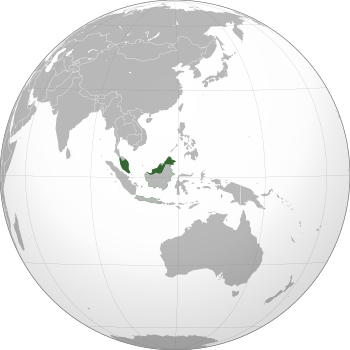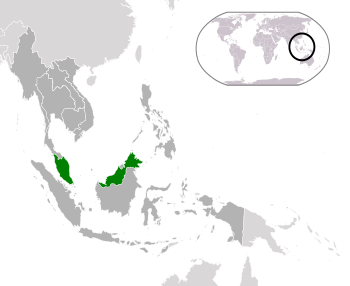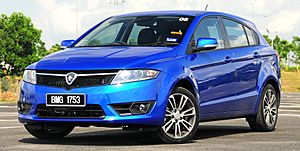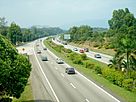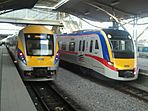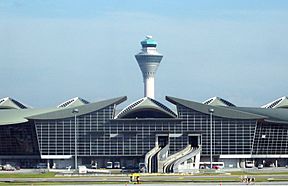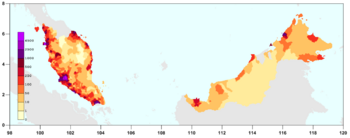Malaysia facts for kids
Quick facts for kids
Malaysia
|
|
|---|---|
|
|
|
|
Anthem: "Negaraku"
"My Country" |
|
| Capital and largest city
|
Kuala Lumpur 3°8′N 101°41′E / 3.133°N 101.683°E |
| Administrative center | Putrajaya 2°56′N 101°42′E / 2.933°N 101.700°E |
| National languages (official) | Malay (de jure) |
| Recognized languages | English (de facto) |
| Ethnic groups
(2023)
|
|
| Religion
(2020)
|
|
| Demonym(s) | Malaysian |
| Government | Federal parliamentary constitutional elective monarchy |
| Ibrahim Iskandar | |
| Anwar Ibrahim | |
| Legislature | Parliament |
| Dewan Negara | |
| Dewan Rakyat | |
| Independence
from the United Kingdom
|
|
| 31 August 1957 | |
|
• Sarawak self-governance
|
22 July 1963 |
|
• North Borneo self-governance
|
31 August 1963 |
| 16 September 1963 | |
| Area | |
|
• Total
|
330,803 km2 (127,724 sq mi) (67th) |
|
• Water (%)
|
0.3 |
| Population | |
|
• 2024 estimate
|
34,564,810 (43rd) |
|
• 2020 census
|
32,447,385 |
|
• Density
|
101/km2 (261.6/sq mi) (116th) |
| GDP (PPP) | 2024 estimate |
|
• Total
|
|
|
• Per capita
|
|
| GDP (nominal) | 2024 estimate |
|
• Total
|
|
|
• Per capita
|
|
| Gini (2021) | ▼ 40.7 medium |
| HDI (2022) | very high · 63rd |
| Currency | Malaysian ringgit (RM) (MYR) |
| Time zone | UTC+8 (MST) |
| Date format | dd-mm-yyyy |
| Calling code | +60 |
| ISO 3166 code | MY |
| Internet TLD | .my |
Malaysia is a country in Southeast Asia. It is a special kind of country called a federation, made up of 13 states. The South China Sea divides Malaysia into two main parts. One part is on the Malay Peninsula, which is on the mainland of Asia. The other part, called East Malaysia, is on the northern side of the island of Borneo.
Kuala Lumpur on the Malay Peninsula is Malaysia's capital city. The government's main offices recently moved to Putrajaya. This is a new city built just for administration. Malaysia is home to many different groups of people. Most are Malay, but there are also Chinese and Indian people.
The official language is Malay, written using the Latin alphabet. English is also widely used. You can hear over 130 other languages spoken across Malaysia. Islam is the official religion. However, people who are not Malay citizens can freely practice other religions.
Contents
- Malaysia's Story
- Malaysia's Amazing Geography
- Amazing Plants and Animals
- Malaysia's Economy
- Getting Around Malaysia
- How Malaysia is Governed
- States and Territories
- Major Cities
- People of Malaysia
- Religions in Malaysia
- Languages Spoken
- Malaysian Culture
- Sports in Malaysia
- Related pages
- Images for kids
- See also
Malaysia's Story
Malaysia's history began with ancient Malay kingdoms. In the 18th century, these kingdoms came under the control of the British Empire. This period was known as British Malaya. During World War Two, Japan took over British Malaya and other nearby areas.
After three years, Peninsular Malaysia briefly became the Malayan Union in 1946. It was then changed to the Federation of Malaya in 1948. The country became independent on August 31, 1957. On September 16, 1963, the independent Malaya joined with North Borneo, Sarawak, and Singapore. Together, they formed Malaysia. In August 1965, Singapore left the federation and became its own independent country.
Malaysia's Amazing Geography
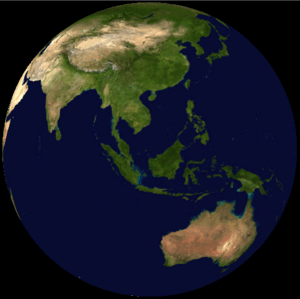
Malaysia is the 66th largest country by land area. It covers about 329,613 square kilometers. Malaysia shares land borders with Thailand in West Malaysia. In East Malaysia, it borders Indonesia and Brunei. A narrow causeway and a bridge connect it to Singapore. Malaysia also has sea borders with Vietnam and the Philippines.
Brunei is almost completely surrounded by Malaysia. The state of Sarawak divides Brunei into two parts. Malaysia is special because it's the only country with land on both the Asian mainland and the Malay islands. Tanjung Piai in the state of Johor is the southernmost point of mainland Asia. The Strait of Malacca, between Sumatra and Peninsular Malaysia, is a very important shipping route. About 40 percent of the world's trade passes through it.
Land and Sea
The two parts of Malaysia are separated by the South China Sea. Both Peninsular and East Malaysia have similar landscapes. They feature coastal plains that rise into hills and mountains. Peninsular Malaysia makes up 40 percent of Malaysia's land. It stretches 740 kilometers from north to south. Its widest point is 322 kilometers across.
The Titiwangsa Mountains divide the peninsula's east and west coasts. These mountains reach a height of 2,183 meters at Mount Korbu. They are part of a mountain range running down the center of the peninsula. These mountains are covered in thick forests. They are also the source of some of Peninsular Malaysia's rivers.
Mountains and Caves
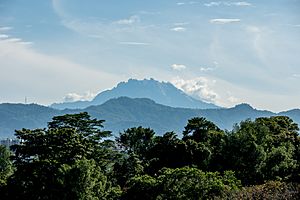
East Malaysia, on the island of Borneo, has a coastline of 2,607 kilometers. It has coastal areas, hills, valleys, and a mountainous interior. The Crocker Range runs north from Sarawak into Sabah. This is where Mount Kinabalu is located. At 4,095 meters high, it is the tallest mountain in Malaysia. Mount Kinabalu is part of the Kinabalu National Park. This park is a World Heritage Site protected by UNESCO.
The highest mountain ranges form the border between Malaysia and Indonesia. Sarawak is home to the Mulu Caves. This is the largest cave system in the world. It is found in the Gunung Mulu National Park, another World Heritage Site.
Climate and Weather
Around Malaysia, there are many islands. The largest is Banggi Island. The local climate is equatorial. This means it's hot and humid all year round. It has two main monsoon seasons: southwest (April to October) and northeast (October to February). The surrounding oceans help keep the temperature steady. Humidity is usually high. The average yearly rainfall is 250 centimeters.
The climate in Peninsular Malaysia is different from East Malaysia. The peninsula's weather is directly affected by winds from the mainland. East Malaysia has more maritime weather, meaning it's influenced by the sea. Local climates can be divided into highland, lowland, and coastal regions. Climate change might cause sea levels to rise and rainfall to change. This could lead to more floods and droughts.
Amazing Plants and Animals
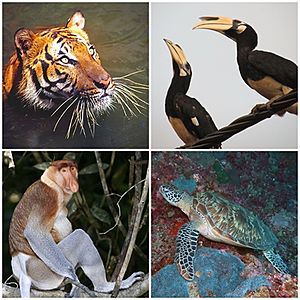
Malaysia is a "megadiverse" country. This means it has a huge number of different plant and animal species. Many species are found only here. It's thought that Malaysia has 20 percent of the world's animal species. The diverse forests on Borneo's mountains have many unique species. This is because they are isolated from each other by lowland forests.
There are about 210 types of mammals in Malaysia. Over 620 bird species have been seen in Peninsular Malaysia. Many of these birds are unique to the mountains there. Malaysian Borneo also has many unique bird species. The country is home to 250 reptile species. This includes about 150 types of snakes and 80 types of lizards. There are also about 150 frog species and thousands of insect species.
Malaysia's sea area is 1.5 times larger than its land area. Some of its waters are in the Coral Triangle, which is a hotspot for sea life. The waters around Sipadan island are the most diverse in the world. The Sulu Sea, bordering East Malaysia, is also very rich in life. It has about 600 coral species and 1,200 fish species. The unique animals and plants in Malaysian Caves attract many visitors who love ecotourism.
Nearly 4,000 types of fungi, including lichens, have been found in Malaysia. Many more fungal species are likely still undiscovered. Some of these might be completely new to science.
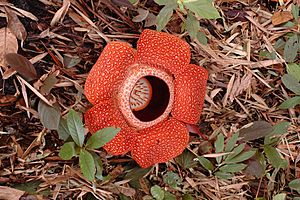
About two-thirds of Malaysia was covered in forest in 2007. Some of these forests are believed to be 130 million years old. These forests are mostly made up of dipterocarp trees. Lowland forests grow in areas below 760 meters. East Malaysia used to be covered in such rainforests. This is because of its hot and wet climate.
There are around 14,500 species of flowering plants and trees. Besides rainforests, Malaysia has over 1,425 square kilometers of mangrove forests. It also has a lot of peat forests. At higher altitudes, you can find oaks, chestnuts, and rhododendrons instead of dipterocarps. Peninsular Malaysia has an estimated 8,500 species of vascular plants. East Malaysia has another 15,000. The forests of East Malaysia are home to about 2,000 tree species. They are one of the most diverse areas in the world. A single hectare can have 240 different tree species. These forests also host many types of Rafflesia. These are the largest flowers in the world, growing up to 1 meter wide.
Malaysia's Economy
Malaysia has one of the largest economies in the world. It ranks 36th by total economic output and 31st when comparing what money can buy.
International trade and manufacturing are very important to Malaysia's economy. The Strait of Malacca helps a lot with shipping trade. Malaysia exports natural resources and farm products. Oil is a major export. Malaysia was once the biggest producer of tin, rubber, and palm oil in the world. Manufacturing still plays a big role in the country's economy. Malaysia remains one of the world's largest producers of palm oil.
Tourism is the third biggest part of Malaysia's economy. It comes after manufacturing and raw materials.
Getting Around Malaysia
Malaysia has a large road network, covering 98,721 kilometers. This includes 1,821 kilometers of expressways. The longest highway, the North-South Expressway, is over 800 kilometers long. It connects the Thai border to Singapore. Roads in Sabah and Sarawak are not as developed as those in Peninsular Malaysia.
Malaysia has 118 airports, with 38 having paved runways. Malaysia Airlines is the official airline. It offers both international and domestic flights. Two other airlines also provide service. The railway system is run by the state. It covers a total of 1,849 kilometers. Kuala Lumpur also has a Light Rail Transit system.
How Malaysia is Governed
Malaysia is a federal constitutional elective monarchy. This means it's a country with a king, but also a government elected by the people. It is the only federal country in Southeast Asia.
The country's head of state is called the Yang di-Pertuan Agong, or "King of Malaysia". The head of government is the Prime Minister. Malaysia also has a parliament and a court system. It was one of the founding members of ASEAN.
States and Territories
Malaysia is made up of 13 states and three federal territories. Eleven states and two federal territories are in Peninsular Malaysia. The other two states and one federal territory are in East Malaysia.
The 13 states are based on old Malay kingdoms. Nine of the 11 Peninsular states still have their royal families. These are known as the Malay states. The King of Malaysia is chosen by and from these nine rulers. He serves a five-year term. The King appoints governors for states without monarchies.
Sabah and Sarawak have more independence than other states. For example, they have their own immigration rules. Sometimes, leaders in states like Penang, Johor, Kelantan, Sabah, and Sarawak have talked about leaving Malaysia. This is usually due to federal involvement in state matters or disagreements over oil money. However, these talks have not led to serious independence movements.
- States
A list of thirteen states and each state capital (in parentheses):
- Federal territories
 Federal Territory of Kuala Lumpur
Federal Territory of Kuala Lumpur Federal Territory of Labuan (Victoria)
Federal Territory of Labuan (Victoria) Federal Territory of Putrajaya
Federal Territory of Putrajaya
Major Cities
Here is a list of some important cities in Malaysia. They are listed by when they officially became cities.
- George Town (January 1, 1957)
- Kuala Lumpur (February 1, 1972)
- Ipoh (May 27, 1988)
- Kuching (August 1, 1988)
- Johor Bahru (January 1, 1994)
- Kota Kinabalu (February 2, 2000)
- Shah Alam (October 10, 2000)
- Malacca City (April 15, 2003)
- Alor Setar (December 21, 2003)
- Miri (May 20, 2005)
- Petaling Jaya (June 20, 2006)
- Kuala Terengganu (January 1, 2008)
People of Malaysia
In 2020, Malaysia's population was 32,447,385 people.
Malaysian citizens are divided into different ethnic groups. About 69.7 percent are considered bumiputera. The largest group of bumiputera are Malays. The constitution defines them as Muslims who follow Malay customs. They have a strong role in politics.
Bumiputera status is also given to native groups in Sabah and Sarawak. These include Dayaks (like Iban, Bidayuh, Orang Ulu), Kadazan-Dusun, Melanau, Bajau, and others. Non-Malay bumiputeras make up more than half of Sarawak's population. They are over two-thirds of Sabah's population. There are also smaller native groups on the peninsula, known as the Orang Asli. Rules for who gets bumiputera status can differ between states.
There are two other main ethnic groups who are not bumiputera. About 22.8 percent of the population are Malaysian Chinese. About 6.8 percent are Malaysian Indian.
Religions in Malaysia
Malaysia has many different religions. Islam is the country's official religion. In 2009, government figures showed the four main religions were:
- Islam (55.4% of the people)
- Buddhism (27.2%)
- Christianity (9.1%, mostly in East Malaysia)
- Hinduism (10.8%)
Languages Spoken
The official and national language of Malaysia is Malaysian Malay. This is a standard form of the Malay language.
English is still an important second language. It can be used for some official purposes under a law from 1967.
Many other languages are spoken in Malaysia. There are speakers of 137 living languages. Peninsular Malaysia alone has speakers of 41 of these languages. The native tribes of East Malaysia have their own languages. These are related to Malay but are easy to tell apart.
Malaysian Culture
Malaysia has a society with many different ethnic groups, cultures, and languages. The first culture in the area came from the native tribes. Later, the Malays moved there. Chinese and Indian cultures have had a big impact. This started when foreign trade began a long time ago. Other cultures like Persian, Arabic, and British have also influenced Malaysia. Because of how the government is set up, different ethnic groups have kept their own cultures.
Traditional Arts
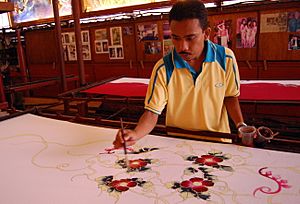
Traditional Malaysian art mainly focused on carving, weaving, and working with silver. Artworks ranged from handwoven baskets made in rural areas to silver items from Malay royal courts. Common art pieces included decorated kris (a type of dagger), sets for chewing beetle nut, and woven batik and songket fabrics. Native East Malaysians are known for their wooden masks.
Each ethnic group has its own unique performing arts. There is not much overlap between them. However, Malay art does show some influence from North India. This is because of India's historical impact.
Traditional Malay music and performing arts likely started in the Kelantan-Pattani area. They were influenced by India, China, Thailand, and Indonesia. The music uses percussion instruments. The most important is the gendang (drum). There are at least 14 types of traditional drums. Drums and other traditional percussion instruments are often made from natural materials. Music is traditionally used for telling stories and celebrating life events. It was once used to communicate over long distances. In East Malaysia, musical groups using gongs are common. They are used in ceremonies like funerals and weddings.
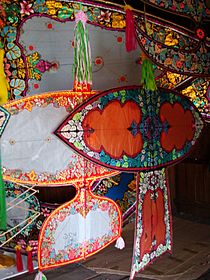
Malaysia has a strong tradition of oral storytelling. This existed even before writing arrived. Each of the Malay Sultanates created their own literature. These were influenced by old oral stories and by stories that came with Islam. The first Malay writings used the Arabic script. The oldest known Malay writing is on the Terengganu Inscription Stone, made in 1303.
Chinese and Indian literature became popular as more speakers of these languages came to Malaysia. Local works in these languages began to be produced in the 19th century. English has also become a common language for literature. In 1971, the government decided how to define literature in different languages. Literature written in Malay was called "the national literature of Malaysia." Literature in other native languages was called "regional literature." Literature in other languages was called "sectional literature." Malay poetry is very developed and uses many forms. The Hikayat form is popular. The pantun has spread from Malay to other languages.
Delicious Malaysian Food
Malaysia's food shows the many different ethnic groups in its population. Many cultures from inside the country and nearby regions have greatly influenced the food. Much of this influence comes from Malay, Chinese, Indian, Thai, Javanese, and Sumatran cultures. This is because Malaysia was part of the ancient spice route. The food is very similar to that of Singapore and Brunei. It also looks a bit like Filipino food.
Different states have their own unique dishes. Often, Malaysian food is different from the original dishes it came from. Sometimes, food from one culture is adopted by another. For example, Chinese restaurants in Malaysia often serve Malay dishes. Food from one culture is sometimes cooked using styles from another. For example, sambal belacan (shrimp paste) is often used by Chinese restaurants to make stir fried water spinach (kangkung belacan). This means that while much of Malaysian food can be traced back to a certain culture, it has its own special identity. Rice is popular in many dishes. Chili is commonly found in local food, but this doesn't always make them spicy.
Holidays and Fun Festivals
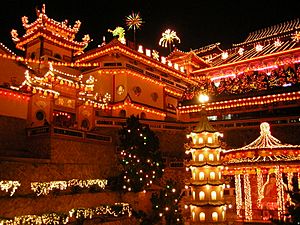
Malaysians celebrate many holidays and festivals throughout the year. Some are national public holidays. Others are celebrated by individual states. Some festivals are for specific ethnic or religious groups. The main holiday of each major group is a public holiday.
The most important national holiday is Hari Merdeka (Independence Day) on August 31. This day celebrates the independence of the Federation of Malaya in 1957. Malaysia Day on September 16 celebrates the formation of Malaysia in 1963. Other important national holidays are Labour Day (May 1) and the King's birthday (first week of June).
Muslim holidays are very important since Islam is the state religion. These include Hari Raya Puasa (also called Hari Raya Aidilfitri, which is Eid al-Fitr), Hari Raya Haji (also called Hari Raya Aidiladha, which is Eid al-Adha), and Maulidur Rasul (the Prophet's birthday).
Malaysian Chinese celebrate festivals like Chinese New Year. Hindus in Malaysia celebrate Deepavali, the festival of lights. Thaipusam is a religious event where pilgrims gather at the Batu Caves. Malaysia's Christian community celebrates holidays like Christmas and Easter. The Dayak community in Sarawak celebrates Gawai, a harvest festival. The Kadazandusun community celebrates Kaamatan.
Even though most festivals are linked to a specific group, everyone celebrates together. Malaysians often visit the homes of friends and neighbors who are celebrating a festival. This custom is known as "open house."
Sports in Malaysia
Popular sports in Malaysia include association football, badminton, field hockey, bowls, tennis, squash, martial arts, horse riding, sailing, and skate boarding. Football is the most popular sport. Badminton matches also attract thousands of fans. Since 1948, Malaysia has been one of only four countries to hold the Thomas Cup. This is the world team championship trophy for men's badminton.
The Malaysian Lawn Bowls Federation was started in 1997. British army members brought squash to the country. The first competition was held in 1939. The Squash Racquets Association of Malaysia was created in 1972. The men's national field hockey team was ranked 10th in the world in June 2022. Kuala Lumpur hosted the 3rd and 10th Hockey World Cup at Stadium Merdeka. The country also has its own Formula One track, the Sepang International Circuit. The first Malaysian Grand Prix was held there in 1999. Traditional sports include Silat Melayu. This is the most common martial art practiced by ethnic Malays.
The Federation of Malaya Olympic Council was formed in 1953. It was recognized by the International Olympic Committee (IOC) in 1954. It first took part in the 1956 Melbourne Olympic Games. The council was renamed the Olympic Council of Malaysia in 1964. Malaysia has participated in almost every Olympic Games since then. The most athletes ever sent to the Olympics was 57, to the 1972 Munich Olympic Games. Besides the Olympic Games, Malaysia also takes part in the Paralympic Games. Malaysia has competed at the Commonwealth Games since 1950 as Malaya, and since 1966 as Malaysia. Kuala Lumpur hosted the games in 1998.
Related pages
- States of Malaysia
- List of rivers of Malaysia
- Malaysia at the Olympics
- Malaysia national football team
Images for kids
-
"Malaysia" used as a label for the Malay Archipelago on a 1914 map from a United States atlas
-
The Dutch fleet battling with the Portuguese armada as part of the Dutch–Portuguese War in 1606 to gain control of Malacca
-
Statue of Francis Light in the Fort Cornwallis of Penang, the first British colony in what was to become Malaysia
-
Topographic map of Malaysia; Mount Kinabalu is the highest summit in the country.
-
Kuala Lumpur, the financial centre of Malaysia
-
A traditional house being built in Sabah
See also
 In Spanish: Malasia para niños
In Spanish: Malasia para niños




